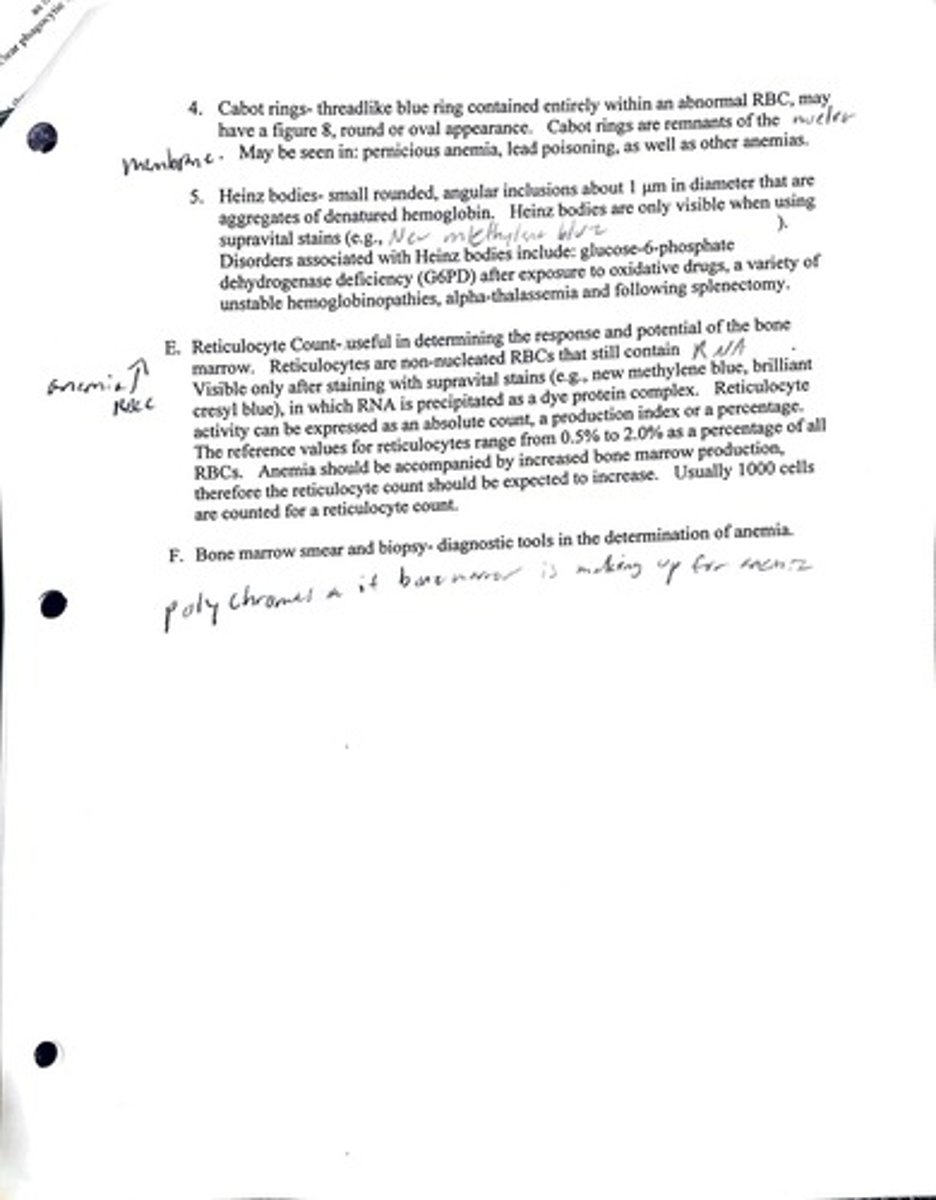Anemia Diagnosis and Classification: Hematology and Clinical Features
1/25
There's no tags or description
Looks like no tags are added yet.
Name | Mastery | Learn | Test | Matching | Spaced |
|---|
No study sessions yet.
26 Terms
What is anemia?
Anemia is the inability of the blood to supply adequate oxygen to tissues for metabolic function.
What are some signs and symptoms of moderate anemia?
Moderate anemia may not produce symptoms, but can include exertional dyspnea, light-headedness, vertigo, muscle weakness, headache, or general lethargy.
What are the symptoms of severe anemia?
Severe anemia can lead to functional impairment of organ systems, increased cardiac and respiratory rates, and significant drops in blood pressure.
What are some conditions associated with lower hemoglobin levels?
Conditions include nutritional deficiencies (folate, vitamin B12), blood loss (hemorrhage), accelerated RBC destruction, ineffective RBC production, and bone marrow suppression.
What is the role of reticulocytes in anemia?
Reticulocytes are early circulating RBCs that indicate bone marrow activity and should increase in response to anemia.
What nutritional factors are necessary for proper hemoglobin synthesis?
Iron, vitamin B12, and folic acid are essential for hemoglobin synthesis and RBC production.
What is the significance of erythropoietin (EPO) in anemia?
EPO is a hormone produced by the kidneys in response to low oxygen tension, stimulating RBC production.
What are common nonspecific signs and symptoms of anemia?
Common signs include fatigue, weakness, and gastrointestinal symptoms like nausea, constipation, or diarrhea.
What are some clinical signs of severe anemia?
Signs may include severe pallor, smooth tongue, and esophageal webs.
What is microangiopathic hemolytic anemia?
A form of mechanical anemia caused by prosthetic heart valves, arterial grafts, or disseminated intravascular coagulation (DIC).
What is aplastic anemia?
Aplastic anemia can be idiopathic or acquired, often caused by exposure to chemicals, therapeutic agents, infections, or radiation.
How is anemia classified?
Anemia can be classified as normocytic, microcytic, macrocytic, normochromic, or hypochromic.
What is the 'Rule of Three' in relation to hemoglobin and hematocrit?
The 'Rule of Three' states that hematocrit is approximately three times the hemoglobin level (±3).
What does mean corpuscular volume (MCV) measure?
MCV estimates the average size of RBCs, expressed in femtoliters (fL).
What is the normal range for mean cell hemoglobin (MCH)?
Normal MCH is 27-31 picograms (pg).
What does mean cell hemoglobin concentration (MCHC) indicate?
MCHC indicates the percentage of hemoglobin in a given volume of packed RBCs, with normal values being 32-36%.
What is red cell distribution width (RDW)?
RDW quantifies the variation in RBC size and is used to assess anisocytosis.
How is anemia treated?
Treatment of anemia is based on its underlying causes.
What is the significance of blood transfusions in anemia diagnosis?
Transfusions can obscure diagnostic findings and suppress erythropoiesis, complicating the interpretation of tests.
What is the cyanmethemoglobin method?
A method for measuring hemoglobin by oxidizing it to methemoglobin and then forming cyanmethemoglobin for spectrophotometric analysis.
What is hematocrit?
Hematocrit is the ratio of the volume of RBCs to the volume of whole blood, usually expressed as a percentage.
What does a peripheral blood smear show?
A peripheral blood smear can reveal abnormalities such as basophilic stippling, Howell-Jolly bodies, Pappenheimer bodies, Cabot rings, and Heinz bodies.

What are Howell-Jolly bodies?
Howell-Jolly bodies are remnants of DNA in RBCs, often seen in conditions like hyposplenism or pernicious anemia.
What are Heinz bodies?
Heinz bodies are aggregates of denatured hemoglobin visible with supravital stains, associated with conditions like G6PD deficiency.
What is the reticulocyte count used for?
The reticulocyte count assesses bone marrow response and potential in anemia, with normal values ranging from 0.5% to 2.0%.
What diagnostic tool is used for bone marrow examination?
Bone marrow smear and biopsy are used to diagnose various types of anemia.